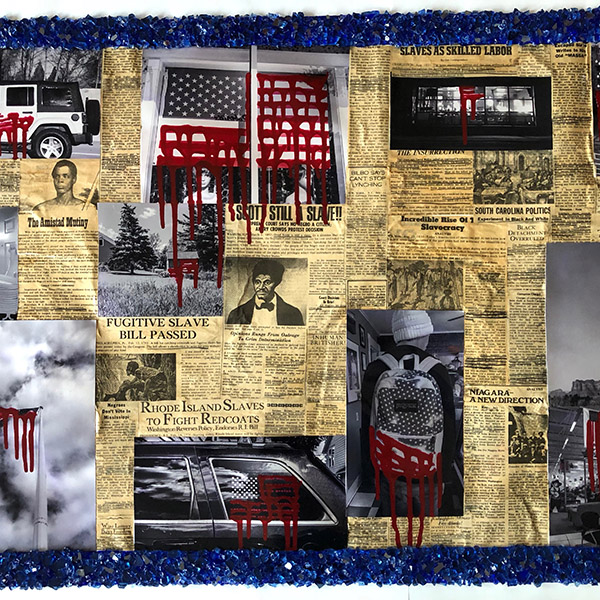Many Americas: Art Meets History
Southern Vermont Arts Center • Manchester, VT • svac.org • Through November 27, 2022

Despite America’s historic designation as a “melting pot,” this exhibit puts forth the theory that “we do not share a common history, and as a result, our divergent histories are the source of our troubled public discourse.” Guest curator Ric Kasini Kadour developed Many Americas: Art Meets History with SVAC during an eighteen-month-long research project funded by the Andy Warhol Foundation for the Visual Arts. Warhol himself would no doubt be pleased with the complexity and variety of the works presented.
We Pledge Allegiance by CoCo Harris, a monumental 3-foot by 10-foot collage, combines historical news clipping from The Black Chronicle and photographs of the American flag, often dripping blood. The yellowed newspaper behind the images is an inescapable testament to the history of racism in America. Nell Irvin Painter’s You say This Can’t really Be America, graphically illustrates diametrically contrasting views, as spoken in the everyday language of the subject portrayed.
Dream Catcher, by Michael Ryder (Ojibwe), employs a starkly moving archive of historical photographs to address bodily trauma and the displacement of native people. Dorothea Osborn’s Rear View is a six-panel fabric installation that shows layers of family history as sediment, underpinning and affecting the present, belying the saying “What you see is what you get.”
Ger Xiong’s Becoming White, an embroidered tapestry, speaks to the experience of Hmong refugees in America. Xiong traces a trajectory of assimilation and the inevitable distancing of his original Hmong culture. HAIRitage, a mixed media work by Erin Smith Glenn, celebrates Black hair culture and the highly original ways that hair is treated. It also emphasizes the importance of salons as community centers, sources of news and information, and sites of resistance and resilience.
These are just a few of the themes in this wide-ranging exhibit that cover a multiplicity of artists. Kasini’s decision to view history through their eyes provides both an intimate and expansive view. The “American experiment” is vibrant and alive, both in its accomplishments and shortcomings—and we all play our part. With this exhibit, the Museum has become a public square, and we are all invited to participate.
—B. Amore
